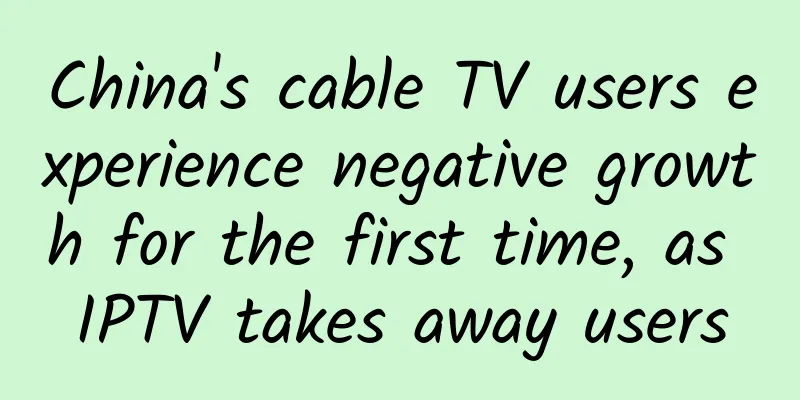China's cable TV users experience negative growth for the first time, as IPTV takes away users

|
The popularity of smart TVs and the technological experience brought by their continuous upgrading are favored by more and more users, while the traditional family TV viewing pattern is under severe impact. At the recently held 4th CCBN Cable Digital TV Operators International Summit, Du Baichuan, an expert from the Science and Technology Committee of the State Administration of Press, Publication, Radio, Film and Television, said that in the fourth quarter of 2016, the number of cable TV users decreased by 2.15 million quarter-on-quarter, showing negative growth for the first time. With telecom operators vigorously developing IPTV and OTT smart TV manufacturers continuing to increase their investment, competition in the television field will become more intense in the future. Traditional cable TV is showing signs of fatigue It was revealed that in the fourth quarter of last year, the number of cable TV users in my country decreased by 2.15 million from the previous quarter, marking the first negative growth; the total number of broadband users reached 25.77 million, with a net increase of nearly 2.5 million in the fourth quarter. At the same time, the number of IPTV users of telecom operators is growing rapidly. Data shows that by the end of 2016, the number of cable TV users was 260 million, a growth rate of 5.37%, while the total number of IPTV users reached 86.79 million, a growth rate of 89%. Although the number of IPTV service users is still far behind that of cable TV, the former is developing more rapidly. Together with China Mobile's more than 20 million OTT TV users, the total number of operator TV users exceeded 100 million in 2016. Du Baichuan said that the household TV viewing pattern is undergoing tremendous changes, and traditional cable TV is being greatly impacted by operators and OTT smart TVs. From a global perspective, the decline of traditional cable TV has also become a common phenomenon. Take the United States as an example. According to statistics released by market research company Nielsen, cable TV is in the early stages of decline in the United States, with more than 5 million Americans no longer watching TV programs through traditional channels. In South Korea, IPTV service users have reached 14 million, while South Korea's cable TV subscribers are 14.5 million. Traditional cable TV industry faces internal and external troubles Why cable TV has shown serious signs of fatigue in recent years requires an analysis of both internal and external factors. First, from the perspective of user demand, OTT smart TVs, mobile phones and other smart terminals are rapidly becoming popular, and users have more diverse ways to watch TV and videos. Second, cable TV’s own lackluster interactive functions and services cannot meet user needs. For example, cable TV’s two-way on-demand services are not well introduced. Some users see the promotion of OTT set-top boxes and want to try new functions, and then buy OTT set-top boxes. However, in fact, cable set-top boxes also have the same functions, but cable TV has not properly and timely communicated them to users. Third, external competition snatches users. In recent years, telecom operators have vigorously developed IPTV services and launched rich and affordable packages that integrate calls, broadband and IPTV services. The business halls of the three major operators are spread all over cities and villages. They use the opportunity of users paying phone bills and handling business to promote IPTV, which has virtually snatched many cable TV users. Fourth, various cheap TV viewing terminals have severely impacted cable TV. Such as Internet set-top boxes, "small iron pots" (live satellite TV), terrestrial digital TV, etc., with their simple and cheap terminal equipment, have eroded the cable TV market. This has also made more and more users believe that cable TV is not the only way to watch TV. The TV market urgently needs to adapt to a new business model The popularity of "Internet +" has driven the transformation of the TV industry. Smart TVs are based on the Internet, prompting a large number of Internet manufacturers to join the battle. According to AVC statistics, the average daily viewing time of smart TVs is 6.01 hours, while the average daily viewing time of traditional TVs is only 4.18 hours (data from December 2016). The household market is constantly changing, and the business model is facing a huge change. The phenomenon of TV users "voting with their feet" shows that market demand is changing, and the business model around TV screens will also change completely. As an important entrance to the home market and smart home, the TV screen will not only be a video playback platform, but also an entrance to life services such as shopping, education, finance, and medical care. As a product that is fixed at home, the most commonly used, and has family attributes, the large screen of the TV enhances the stickiness and user experience of the TV, and also becomes the most ideal traffic entrance for "Internet +" families. At present, China Radio and Television Network Co., Ltd. has become the fourth largest basic telecommunications operator. In the future, wireless communication business may become its new revenue growth point. Judging from the development of IPTV of the three major operators, China Telecom, which is ahead of the curve, still maintains its leading position. The only variable is when China Mobile can obtain the IPTV license. Once China Mobile obtains the IPTV license, the impact on cable TV will be even greater. In addition, TV manufacturers such as Changhong, Hisense, and Skyworth are constantly exploring the artificial intelligence market. These market "variables" indicate that in 2017, the battle between radio and television operators, telecommunications operators, and many OTT smart TV manufacturers will become more intense. At present, cable TV users are still the core of the household TV viewing market. Data shows that in 2016, the scale of cable TV users in my country accounted for 59.6% of the national household TV viewing market, followed by live satellite, IPTV, and OTT TV. Although cable TV still has an advantage in China's household TV viewing market, it is obviously facing more severe internal and external troubles. Only by enhancing business adhesion and user experience, reducing user experience costs, improving service levels, and adapting to new business models and competition patterns can new business value be tapped. As a winner of Toutiao's Qingyun Plan and Baijiahao's Bai+ Plan, the 2019 Baidu Digital Author of the Year, the Baijiahao's Most Popular Author in the Technology Field, the 2019 Sogou Technology and Culture Author, and the 2021 Baijiahao Quarterly Influential Creator, he has won many awards, including the 2013 Sohu Best Industry Media Person, the 2015 China New Media Entrepreneurship Competition Beijing Third Place, the 2015 Guangmang Experience Award, the 2015 China New Media Entrepreneurship Competition Finals Third Place, and the 2018 Baidu Dynamic Annual Powerful Celebrity. |
>>: Dongfeng A9 real shot at Guangzhou Auto Show: copying Passat to the end
Recommend
Why are cinema seats red? It's not about creating an atmosphere, it's about our cells
Those who often go to the cinema to watch movies ...
Two ice creams for 45? Which ice cream have you ever paid for?
Nowadays, if you pick up an ice cream at a conven...
CP Marketing Strategy of Internet Celebrities
The most popular CP on Tik Tok has broken up. On ...
Amazon announces video download support, which will impact film and television retail
Amazon and Netflix have been competing fiercely i...
McDonald’s community operation strategy!
More and more companies are starting to develop t...
A case of cholera has occurred at Wuhan University! What is cholera? How to prevent it? 10 hot questions and answers
At about 11:00 today, the Health and Health Burea...
Foreign media: US judge suspends US Commerce Department's WeChat removal order
According to Overseas Network (the official websi...
5 classic marketing strategies to attract new users!
The most fundamental core of an enterprise's ...
[Fighting the "Three Summers" to Ensure a Good Harvest] In addition to the "rotten rain", wheat harvests also need to guard against these meteorological disasters
At present, wheat has gradually entered the conce...
How to increase the volume of Baidu bidding account promotion?
Just now, friends in the group were discussing th...
From the perspective of games, what are the “routines” that can be learned to increase user stickiness?
Games and gamification activities naturally have ...
Do you understand the “blood” of the earth?
Do you understand the “blood” of the earth? Quest...
Adapting ATS from server to iOS client
iOS 9 has been released, and everyone has to expe...
How do huge surface ships evade sensitive radar?
With the development of modern detection equipmen...
What happens to people who skip dinner for a long time? These 6 consequences are shocking!
As the old saying goes: "Eat a good breakfas...









